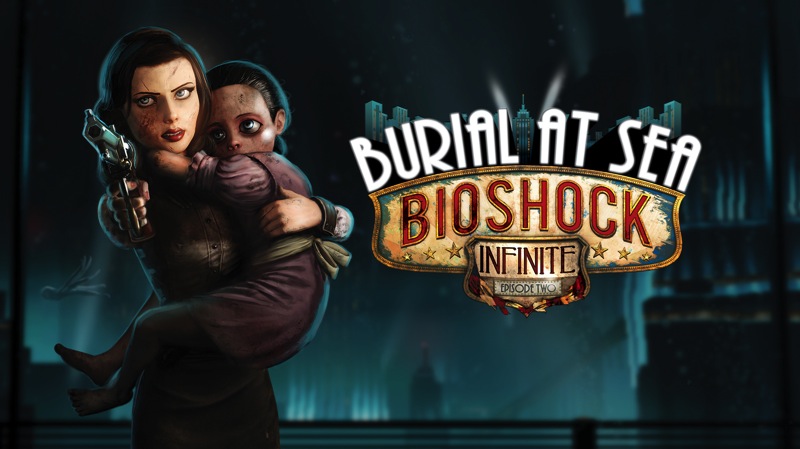
With the release of the second and final part of Bioshock Infinite‘s story-driven downloadable content last month (accompanied by precious little press coverage), now seems a good time to review the package as a whole, and also to briefly look back at the entire Bioshock series. With the recently-announced closure of studio Irrational Games, Burial at Sea looks to be the last installment in this groundbreaking gaming saga, or at least the last installment featuring the work of Ken Levine, the man who masterminded the compelling and mind-bending story arcs of 2008’s Bioshock and last year’s Bioshock Infinite.
Part 1 of Burial at Sea features a jarring combination of characters and setting which are both familiar to fans of the series, but from different sources. Seeing Booker and Elizabeth (the former apparently having no memory of the latter) joining forces to hunt for a missing girl in pre-revolutionary Rapture is an intriguing spectacle, and right from the start has the player asking questions about what’s really going on. It’s a strange melding of worlds; gameplay elements such as carrying multiple weapons and the use of “plasmids” rather than “vigors” are carried over from the original Bioshock, whereas skylines, Kinetoscopes and the appearance of “tears” all carry over from Infinite. The episode continues in the series’ traditional vein of being a first-person shooter with RPG elements, and as such doesn’t offer a radical departure in terms of player experience. What it does offer, though, is an interesting story which ends in a shocking twist, after having (as is now par for the course with the series) drip-fed clues to the player about what has really been happening all along. Whilst being a neat little tale which is fun to play through, part 1 is essentially a self-contained story that does little to advance the overall plot of the Bioshock/Infinite series. The same, however, cannot be said of the second episode.

While part 1 of Burial at Sea largely serves to set up part 2, the latter is more ambitious with both its storytelling and its gameplay. Acting as both sequel to Infinite and prequel to the original Bioshock, part 2 closes the link between the two games and further explores the themes of free will, identity and sacrifice which have characterised the series as a whole. The player takes control of Elizabeth as she makes her way through war-torn Rapture, with a brief detour to a Columbia in the throes of its own revolution, resulting in a much more stealth-orientated adventure. Limited ammunition and combat skills mean that the player must try to creep up on enemies without being seen, in a manner that’s refreshingly different from the gung-ho approach of earlier games in the franchise. In terms of atmosphere, there’s a return to the more horror-based vibe of Bioshock, with a cavernous, mildewed department store in Rapture and Jeremiah Fink’s macabre lab in Columbia standing out as particularly creepy highlights. The game’s unrelentingly dark final act also features a gut-wrenching torture sequence, before coming to an emotional conclusion which, as Ken Levine suggested in several pre-release interviews, offers a strange kind of closure to fans of the series.
Despite feeling more like an addendum to the original game rather than 2013’s Bioshock Infinite, Burial at Sea tells us little that’s new about the art-deco nightmare world of Rapture, except for fleshing out the back-stories of supporting characters like Sander Cohen and Yi Suchong. It does engage with some of the metaphysical mysteries left unresolved by the plot of Infinite, but still leaves plenty of questions for players to ponder over. In particular, the story of Columbia revolutionary Daisy Fitzroy is given an intriguing new twist which does a neat job of explaining a rather too-quick character transformation in Bioshock Infinite, one which, whilst thematically justifiable, never sat right with many gamers. If there’s one major complaint to be levelled at Burial at Sea, it’s that the incorporation of characters and elements from Bioshock Infinite into the setting of the original Bioshock could be seen as an exercise in ‘shoehorning’. The story of an objectivist paradise beneath the ocean waves, however, was always full of mystery, its indistinct edges blurring into deep shadows which left a wealth of space for spin-off storytelling. Booker and Elizabeth’s unlikely adventure in Rapture fits neatly within this space, and so manages to avoid feeling like a laboured afterthought.

This review, as you’ll have noticed, has concentrated more on the storytelling aspect of Burial at Sea than its gameplay elements. This is because the greatest strength of the Bioshock series has always been its ability to emotionally engage players with its epic yet intimate stories of crumbling utopias built by all-too-human demagogues. Many reviewers have complained about the supposed clunkiness of Infinite‘s gameplay, a fault allegedly carried over to Burial at Sea (at least until the switch to stealth in part 2), but such complaints miss the point of the whole experience. Infinite‘s (and by extension Burial at Sea‘s) gameplay is far from revolutionary, but it does its job perfectly well, and that job is to facilitate the overall experience of mystery, action, adventure and social commentary which the original Bioshock began and which Burial at Sea continues admirably. Taken as a whole, the Bioshock series becomes an epic morality play about American history and the gruesome dangers of scientific progress driven by ideology, as well as a heart-rending tale of broken families and the (multi-)universal resonance of loving acts of sacrifice. It is arguably the best example yet of gaming as a legitimate medium for storytelling.





